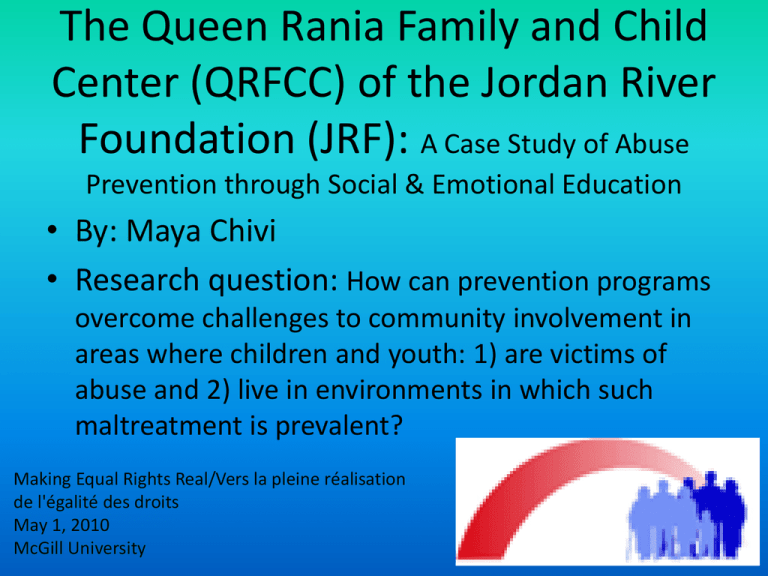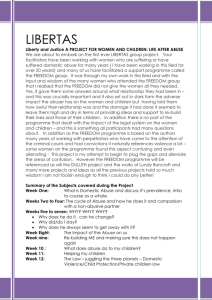
The Queen Rania Family and Child
Center (QRFCC) of the Jordan River
Foundation (JRF): A Case Study of Abuse
Prevention through Social & Emotional Education
• By: Maya Chivi
• Research question: How can prevention programs
overcome challenges to community involvement in
areas where children and youth: 1) are victims of
abuse and 2) live in environments in which such
maltreatment is prevalent?
Making Equal Rights Real/Vers la pleine réalisation
de l'égalité des droits
May 1, 2010
McGill University
Jordan
• Population:
• 70% under age of 30; 60% under age of 24
• Jordanians, Palestinians, Palestinian and Iraqi refugees, Circassians
• Almost half of Jordan’s children face abuse in their homes,
schools, and communities*
• In 2009, 4 children died as a result of
abuse; none of whom were over the
age of 5*
• Case study research was conducted in
Jabal Al Nasr, located in Eastern Amman
*Reference: JRF (2004). Have your say: Child abuse. Retrieved March 2009, from
http://www.jordanriver.jo/
Methodology
• Data collected in June, July, and August 2009
• Conducted 54 semi-structured interviews with
workshop trainers, program directors, and
participants
• Observed child, youth, and adult programs
• Collected field notes
*Girls with puppets their mothers created
at the QRFCC’s puppet-making workshop for women
*Youth Summer Leadership Program volunteers
Issues Faced by Jabal Al Nasr’s Children
and Youth
In the Community:
• Poor family communication
• Poor marital relations
• Neglect & all types of abuse at
home
• Kidnappings
• Road accidents
• Child labour
• Street children and youth
• High rates of unemployment
• Dependency on drugs, glue
sniffing, & alcohol
• Lack of playgrounds
In Schools:
• Bullying
• Sexual harassment
• Abuse between students &
between teachers & students
• Use of beating sticks
• Overpopulated classrooms
(over 40 children)
• Two shifts of schools to
accommodate the number of
students
• Schools are in very poor
conditions
* Youth of Tomorrow Committee members in the playground they won funding to renovate in a national contest
Issues Faced by Jabal Al Nasr’s Girls
•
•
•
•
•
Not allowed to participate in physical activities
Not allowed to leave the house unaccompanied
Honour killings as a result of sexual abuse
Early school dropouts
Early marriages
* Girls with puppets their mothers created at the QRFCC’s puppet-making workshop for women
The QRFCC & the Jabal Al Nasr
Community
• Population of over 250,000 people
• Approximately 100 schools
• The QRFCC:
• Established in 2005 to focus on child and youth
abuse prevention
• Only non-religious community center
• Funded by donors; Free to community members
• Working to realize children and youth’s rights to:
•
•
•
•
•
Safety and security
Health
Care and nurture
Mental and body integrity
Protection from abuse
*Example of photo used during children and youth’s
workshops to increase emotional intelligence
The QRFCC’s Growth
Dar Al Aman
(“Safe House”) :
Child and Youth
Abuse
Intervention
2000
The QRFCC:
Child and
Youth Abuse
Prevention
2005
Youth Volunteer
Leadership
Program
Children:
Boys and
Girls
Youth
Youth of
Tomorrow
Committee
Women:
Training
Center
Establishment
of the Gym:
For Women
and Girls
Safe Schools
Project
Fathers:
Training
Center
Community
Leaders
Directors
Students
Teachers
This growth chart represents JRF’s initial work in abuse intervention under the Child Safety Program to next begin to work on abuse prevention
through the establishment of the QRFCC and it’s sub-units
The QRFCC’s Units
• Local Community Center
• Interactive Mediums Unit Workshops (Arts in child safety,
drama, IT lab, interactive library, and fit for life {for women and girls
only})
• Children, Youth, Mothers
• Youth Programs
• Training Center
• Mothers, Fathers
• Community Leaders
• Safe Schools Project
Children &
Youth’s Social &
Emotional
Development
The QRFCC: Coming Full Circle
Children
Schools
Youth
Community
Leaders
Women and
Mothers
Men and
Fathers
This graph shows how the QRFCC’s work involves and engages all members of the community
The QRFCC:
Impact in the Community
• The center’s strategy focuses on a slow growth into
the community versus a shift in target group focus
• The center’s adopted model covers a full spectrum of
social needs
• Affects individuals in two stages:
• Causes changes in attitudes and behaviours which
then causes active responses
• Reaches indirect beneficiaries by empowering those
around them (e.g.: women who cannot leave their
homes).
* Youth of Tomorrow Committee members in the playground they won funding to renovate in a national contest
The QRFCC’s Challenges
• Seen as “foreign” by local community members
• Cultural taboos and gender stereotyping continues to
discourage participation
• Lack of program continuity with former participants
• Changing municipality and government officials
• Tension between a fast growth to meet the
community’s needs and a focus on slow community
change
* The playground’s surrounding walls at the time the research was conducted
Lessons Learned
• The QRFCC’s successes are the result of:
• Their flexibility and adaptability in response to the
community’s needs
• Their targeting of the social population and
community issues versus focusing on individual
problems
• Their adopted model covers a full spectrum of
social needs
• Grew to cover additional target groups versus a
shift in focus
*Youth Summer Leadership Program volunteers playing games aimed at team building and East and West youth integration
Discussion
• What will the QRFCC’s long term impact on the
individual level be?
• What will the overall impact be in the
community as a whole?
Target: social
Impact: Individual
Result: Community?
*Youth Summer Leadership Program volunteers playing games aimed at team building and East and West youth integration
*A QRFCC staff member hanging paintings created after the death of two brothers as a result of child abuse (both were under the age of 5)
*Youth explaining their drawing on their imagined community with the researcher
Recent photos of the Youth of Tomorrow
Committee’s renovations in the local park
Recent photos of the Youth of Tomorrow
Committee’s renovations on the local park






